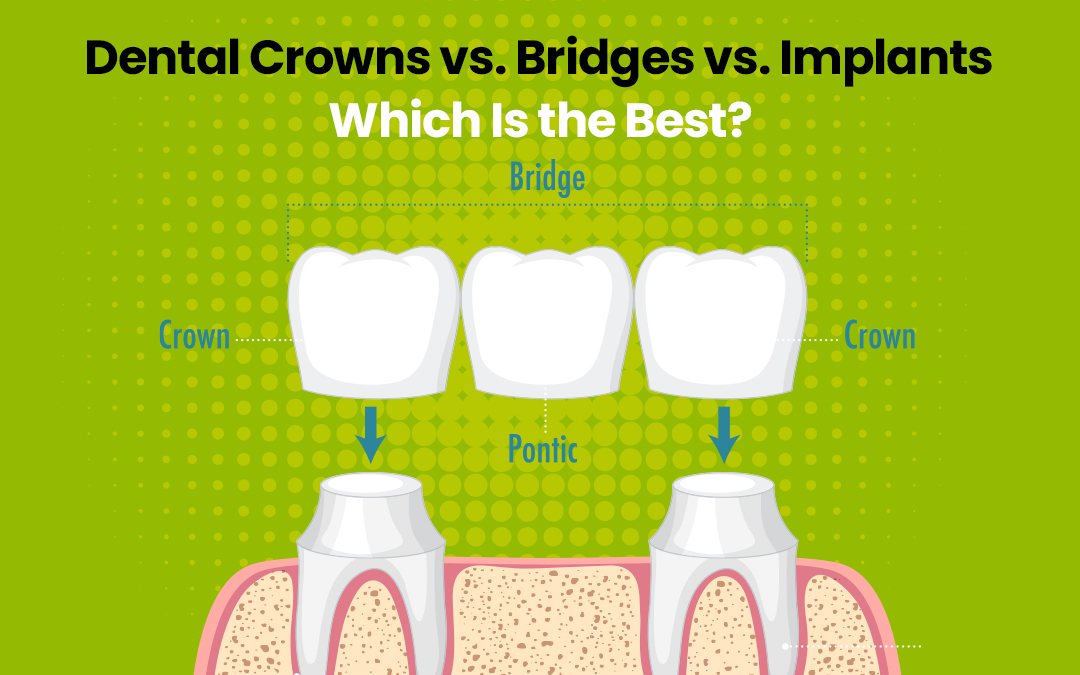
Imagine you're a dental patient faced with the choice of how to repair damaged or missing teeth. Dental crowns, bridges, and implants are three popular solutions, each with its own set of benefits and uses. Understanding how each option works and what it offers can help you make the best decision for your specific dental needs.
Let's break down what dental crowns, bridges, and implants are, how they work, and what they each offer. By knowing these options, you'll be able to choose the best solution for getting your smile back to its best.
Dental Bridges
A dental bridge replaces one or more missing teeth by attaching an artificial tooth (or teeth) to the natural teeth or implants next to the gap. The bridge has two or more crowns on the nearby teeth or implants, with a false tooth (or teeth) in between.
Advantages:
- Restoration: Bridges help replace missing teeth, restoring their function and appearance.
- No Surgery Required: Unlike implants, bridges don't need any surgery.
- Stability: They stay securely in place by attaching to nearby teeth or implants, offering solid support.
Disadvantages:
- Reshaping Neighboring Teeth: Nearby teeth need to be reshaped for the crowns, which can impact their health over time.
- Longevity: Bridges usually last 5-15 years but might need replacement or adjustment eventually.
- Decay Risk: The supporting teeth can be prone to decay if not well cared for.
Dental Crowns
A dental crown is a cap that is positioned over a broken tooth to restore its strength, appearance, and structure. It’s used for teeth that are very decayed, cracked or have had a root canal. Crowns can also cover dental implants or make a tooth look better. They enable you to bite and chew comfortably once more by protecting and restoring the tooth.
Advantages:
- Protection: Crowns shield a weakened tooth from getting damaged further, helping it stay healthy.
- Restoration: They bring back the tooth’s original function and look, so you can bite and chew normally.
- Durability: With good care, crowns can last 10-15 years, making them a long-lasting solution.
- Versatility: Crowns can be made from different materials like porcelain, ceramic, or metal to suit your needs and preferences.
- Customization: They can be designed to match the color and shape of your natural teeth, blending seamlessly with your smile.
Disadvantages:
- Preparation: The tooth needs to be reshaped, which involves removing some of the tooth’s natural structure.
- Potential Sensitivity: After placement, the tooth may experience some sensitivity to temperature or pressure. This is usually temporary but can be uncomfortable for some patients.
- Cost: Crowns can be expensive, especially if they are made from high-quality materials.
Dental Implants
A dental implant is a surgical procedure that involves placing a titanium post into the jawbone to serve as a replacement root for a missing tooth. Once the implant integrates with the bone, a crown is placed on top to complete the restoration.
Advantages:
- Durability: Implants can last a lifetime with proper care.
- Bone Health: Implants help preserve jawbone density by stimulating bone growth.
- Functionality: They function like natural teeth, allowing normal chewing and speaking.
- No Impact on Adjacent Teeth: Implants do not require reshaping of adjacent teeth.
Disadvantages:
- Surgical Procedure: Implant placement requires surgery, which involves a longer recovery time.
- Cost: Implants can be more expensive than crowns or bridges.
- Time: The process can take several months, including healing time and the placement of the final crown.
Which Is Best?
Comparison Table
| Feature | Dental Crowns | Dental Bridges | Dental Implants |
|---|---|---|---|
| Purpose | Restore damaged tooth | Replace one or more missing teeth | Replace missing tooth |
| Procedure | Capping a prepared tooth | Anchoring false teeth to adjacent teeth or implants | Placing a titanium post in the jawbone |
| Durability | 10-15 years | 5-15 years | Lifetime |
| Impact on Adjacent Teeth | Minimal | Requires reshaping adjacent teeth | No impact |
| Bone Preservation | None | None | Preserves bone density |
| Cost | Moderate to high | Moderate to high | High |
| Time Required | Short-term procedure | Short-term procedure | Several months (including healing) |
| Surgical Involvement | None | None | Yes |
Choosing between dental crowns, bridges, and implants depends on several factors, including your specific dental needs, budget, and preferences.
Dental Crowns are ideal for restoring a single damaged tooth and can be a good option if the adjacent teeth are healthy. They are less invasive than implants and do not require surgery.
Dental Bridges are suitable for replacing one or more missing teeth when implants are not an option or if the adjacent teeth need crowns anyway. They provide a quicker solution but may affect the adjacent teeth in the long run.
Dental Implants are often considered the best option for replacing missing teeth due to their durability and bone-preserving qualities. They are particularly advantageous if you are missing multiple teeth or want a solution that does not involve altering neighboring teeth. However, they require a surgical procedure and a longer time frame.
Wrapping Up
Each dental restoration option, including crowns, bridges, and implants, has its own set of advantages and limitations. Consulting with your dentist will help you make an informed decision based on your individual needs and circumstances. Whether you need a crown, bridge, or implant, taking proactive steps to maintain your dental health and following your dentist’s advice will ensure the longevity and success of your chosen restoration.
Share this post
Leave a comment
All comments are moderated. Spammy and bot submitted comments are deleted. Please submit the comments that are helpful to others, and we'll approve your comments. A comment that includes outbound link will only be approved if the content is relevant to the topic, and has some value to our readers.

Comments (0)
No comment